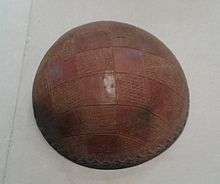A-Group culture
The A-Group culture was an ancient civilization that flourished between the First and Second Cataracts of the Nile in Nubia. It lasted from c. 3800 BCE to c. 3100 BCE.[1]
Overview

In 1907, the Egyptologist George A. Reisner first discovered artifacts belonging to the A-Group culture.[2] Early hubs of this civilization included Kubaniyya in the north and Buhen in the south, with Aswan, Sayala, Toshka and Qustul in between.[1]
The A-Group makers maintained commercial ties with the Ancient Egyptians. They traded commodities like incense, ebony and ivory gathered from the southern riverine area, as well as carnelian from the Western Desert and gold mined from the Eastern Desert in exchange for Egyptian products, olive oil and other items from the Mediterranean basin.[1]
Excavations at an A-Group cemetery in Qustul yielded an old incense burner, which was adorned with Ancient Egyptian royal iconography. However, further research established the antecedence of the predynastic Egyptian regalia:
The earliest known examples of Egyptian royal iconography, such as, e.g., the representation of the Red Crown on a late Naqada I (c. 3500 BCE) pottery vessel from Abydos or the triumphal scenes in the painting from Hierakonpolis Tomb 100 (c. 3400-3300 BCE) are much older than the Qustul censer. It seems thus that it was the Qustul rulers who adopted symbols of royal authority developed in Egypt and not vice versa.[3]

The A-Group makers left behind a number of cemeteries, with each necropolis containing around fifty graves. Most of what is known about this culture has been gleaned from these tombs, over 3,000 of which have been excavated. The burials are of two kinds: a more common oval pit, and a similar pit featuring a lateral funerary niche. Skeletons found within these graves were observed to be physically akin to their peers in Upper Egypt. The specimens typically had straight hair of a black or dark brown hue. On average, the men were 169.9 cm in height and the women stood around 155.5 cm. Some individuals were wrapped in leather and positioned on reed mats. All of the tombs contained various burial items, including personal ornaments, utensils and ceramics.[4]
The A-Group culture came to an end around 3100 BCE, when it was quashed by the First Dynasty rulers of Egypt.[1]
See also
References
- 1 2 3 4 "Ancient Nubia: A-Group 3800–3100 BC". The Oriental Institute. Retrieved 1 July 2016.
- ↑ Shinnie, Peter L. (2013). Ancient Nubia. Routledge. p. 43. ISBN 1136164650. Retrieved 30 June 2016.
- ↑ Török, László. Between Two Worlds : The Frontier Region Between Ancient Nubia and Egypt, 3700 BC-AD 500. In Probleme Der Ägyptologie. Leiden: Brill. 2009. ISBN 9789004171978
- ↑ Shinnie, Peter L. (2013). Ancient Nubia. Routledge. p. 50. ISBN 1136164650. Retrieved 30 June 2016.
External links
- Early States and the A-Group 'Proto-Kingdom'
- Regional variations in the so-called “A-Group” Culture of Lower Nubia
- Hans-Åke Nordström: The Nubian A-Group
- Maria Gatto: Hunting for the Exclusive Nubian A-Group People; Renée Friedman: Setting the Scene
- Nubian Cultures: A and C-Group
- Early Burials: A-Group and C-Group
- The Exhibit of Nubian Antiquities
- Nancy C. Lovell: Nubian A- and C-Groups
- Maria Carmela Gatto: The Nubian A-group: a reassessment